Sex and Porn Addiction
Sex & Porn Addiction – Signs, Causes, Effects & Treatment
Sex and porn addiction, also known as hypersexual disorder or compulsive sexual behaviour, is a condition where an individual becomes excessively preoccupied with sexual thoughts, behaviours, or consumption of pornography. This addiction can manifest in various ways, including an uncontrollable urge to engage in sexual activities, compulsive consumption of pornography, and a constant search for sexual gratification despite negative consequences.
Over time, these behaviours can disrupt an individual’s personal life, relationships, mental health, and overall well-being. Similar to other behavioural addictions, sex and porn addiction activates the brain’s reward system, leading to compulsive behaviour that can be difficult to control without professional help. The compulsive nature of the disorder often results in feelings of guilt, shame, and a loss of control, making it challenging for individuals to break the cycle on their own.
How Common is Sex & Porn Addiction?
Sex and porn addiction are becoming more widely recognized as serious behavioural health concerns. In the U.S. alone, studies suggest that 3-6% of the population may struggle with sex addiction, while 3-5% may experience porn addiction. These conditions frequently occur alongside other mental health disorders, contributing to relationship issues, anxiety, and depression. The easy availability of online explicit content has made porn addiction a growing societal issue.
Understanding these addictions is crucial because they don’t just affect the individual – they have broader social impacts. Porn addiction can distort views of intimacy, damage relationships, and set unrealistic sexual expectations. In extreme cases, it may even foster unhealthy attitudes toward sex. Addressing the issue reduces the stigma around seeking help and promotes healthier societal attitudes toward sexual health.
Why is Sex and Porn Addictive?
Sex and porn are addictive because they stimulate the brain’s reward system, much like drugs and alcohol do. When a person engages in sexual activities or consumes pornography, the brain releases dopamine, a neurotransmitter associated with pleasure and reward. This release creates euphoria and satisfaction, reinforcing the behaviour and encouraging repeated engagement. Over time, the brain begins to associate these activities with pleasure, making it difficult to resist the urge to seek out sexual gratification.
The easy accessibility and anonymity of online pornography contribute to its highly addictive nature. With just a few clicks, individuals can access an endless array of content, which can quickly lead to compulsive viewing. The novelty and variety of pornographic material also play a role in addiction, as the brain continually seeks out new and more stimulating content to achieve the same level of pleasure. This process can lead to desensitisation, where individuals require increasingly explicit or extreme material to experience the same level of arousal, further entrenching the addiction.
For some, sexual behaviour or porn consumption becomes a way to cope with stress, loneliness, or emotional pain. The temporary relief can create a strong psychological dependency, making it even harder to break free without help.
Is Sex & Porn Addictive from the First Try?
Sex and porn usually aren’t addictive after just one exposure, but the risk increases with repeated engagement. The initial pleasure or excitement can be highly reinforcing, prompting individuals to return for more. Over time, this behaviour can become habitual, leading to dependency. While not everyone will develop an addiction, those who do may find it increasingly difficult to control their urges as the addiction deepens.
Signs of Sex & Porn Addiction
Recognising the signs of sex and porn addiction is crucial for early intervention and treatment. This addiction can manifest through various physical, psychological, and behavioural symptoms:
- Physical Signs: Though not as obvious as substance addiction, individuals may experience physical strain, fatigue, or sleep disturbances from compulsive sexual activity or excessive time spent viewing pornography.
- Psychological Signs: These include intense cravings for sexual activities or porn, feelings of guilt or shame, and anxiety or irritability when unable to engage in these behaviours. Over time, this can lead to depression, low self-esteem, and isolation.
- Behavioural Signs: Excessive time spent on sexual activities or pornography, neglecting work, school, or family responsibilities, and engaging in risky or inappropriate sexual behaviours.

Causes, Effects, and Treatment
Causes of Sex & Porn Addiction
- Genetic Factors: Some individuals may have a genetic predisposition that affects how their brain responds to sexual stimuli, increasing their vulnerability to addiction.
- Psychological Factors: Conditions such as depression, anxiety, or PTSD can make individuals more likely to develop a sex or porn addiction, as they seek temporary relief from their mental health struggles.
Social and Environmental Factors: Early exposure to sexual content, societal attitudes toward sex, and high-stress environments can all contribute to addiction. For some, sex or pornography may become a way to
Side Effects of Sex & Porn Addiction
Short-Term Effects
- Relationship Strain: One of the first signs of addiction is strain on relationships, as individuals may prioritize sexual activities or pornography over their partner, leading to emotional distance, dishonesty, or conflict.
- Decreased Productivity: Decline in productivity at work or school, as individuals may spend excessive amounts of time engaging in sexual activities or viewing pornography, neglecting their responsibilities.
- Emotional Distress: The highs and lows associated with sex and porn addiction can lead to emotional instability, including feelings of guilt, shame, and despair.
Long-Term Effects
- Severe Relationship Problems: Sex and porn addiction can lead to infidelity, decreased intimacy, and sexual dysfunction. Over time, this can result in the breakdown of marriages, partnerships, and relationships with family or friends.
- Mental Health Disorders: The addiction is often associated with severe mental health issues, including depression, anxiety, and an increased risk of suicidal thoughts or behaviours.
- Social Isolation: As the addiction progresses, individuals may withdraw from social circles, worsening their feelings of loneliness and despair.
Treatment Methods for Sex & Porn Addiction
Cognitive Behavioural Therapy (CBT): CBT is an evidence-based approach that helps individuals understand and change the thought patterns and behaviours that contribute to their addiction. By addressing the underlying psychological issues that lead to addiction, CBT can be a critical component of long-term recovery.
12 Step Model: Modelled after Alcoholics Anonymous, programs such as Sex Addicts Anonymous (SAA) or Sex and Love Addicts Anonymous (SLAA) provide a 12-step framework for recovery, emphasising the significance of peer support, personal responsibility, and spiritual development. These programs help individuals build a support network and develop strategies for maintaining sobriety beyond formal treatment through global access to 12 Step Meetings.
Rehabilitation Programs: Inpatient rehabilitation provides a structured environment where individuals can focus entirely on their recovery. Outpatient programs offer similar treatment but allow individuals to continue living at home while attending therapy sessions. Both approaches can be effective, depending on the severity of the addiction.
How is Sex & Porn Withdrawal Treated?
Sex and porn addiction withdrawal, while not as physically intense as withdrawal from substances, can still be difficult. Symptoms may include strong cravings, irritability, anxiety, depression, and difficulty focusing. Behavioral therapies, such as CBT and group therapy, are key to managing these symptoms and developing healthy coping mechanisms. In severe cases, inpatient treatment may be necessary, especially for individuals who struggle with co-occurring mental health conditions. In such settings, intensive therapy and care help individuals navigate withdrawal and recovery in a safe and supportive environment.
How Can You Help a Person with Sex & Porn Addiction?
- Encourage Open Communication: Approach them with empathy, express concern without judgment, and let them know you’re there to help.
- Educate Yourself: Learn about the addiction’s signs, symptoms, and treatment options to offer informed support.
- Suggest Professional Help: Overcoming sex and porn addiction is incredibly difficult without professional assistance. Encourage the person to seek help from addiction specialists, counsellors, or rehabilitation programs that can offer the resources and support needed for recovery.
- Explore Treatment Options Together: Help the person explore available treatment options. Additionally, offering to accompany them to appointments or meetings can provide additional moral support.
Taking the first step towards recovery from sex and porn addiction can be difficult, but real change is possible with the right support. At 12 Step Rehabs, we are here to help you or your loved one find a treatment plan tailored to your unique needs. With over 25 years of combined sobriety and personal recovery experience, our compassionate team is ready to guide you every step of the way. Begin your journey toward healing and a healthier life by scheduling a free consultation today.

